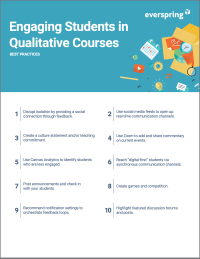Search
There are 8 results.
Tag
Tag
All (98)
Active Learning (2)
Activities (2)
Alt Text (2)
Analytics (4)
Assessments (4)
Asynchrony (3)
Authentic Activities (2)
Backwards Design (1)
Belonging (1)
Branching Scenarios (1)
Canvas (9)
Case Studies (2)
Collaboration (5)
Color Contrast (2)
Communication (7)
Community (7)
Content Creation (5)
Content Curation (1)
Content Delivery (1)
Copyright (2)
Course Maintenance (5)
Course Materials (5)
Course Preparation (5)
Discussions (5)
Diversity (2)
Equity (2)
Faculty Presence (1)
Feedback (5)
Formative Assessments (4)
Game-Based Learning (2)
Gamification (1)
Grading (1)
Group Work (2)
Images (1)
Inclusion (2)
Infographics (2)
Learning Objectives (3)
Multimodality (4)
Page Design (1)
Peer Review (1)
Peer Reviews (1)
PowerPoint (2)
Presentations (2)
Qualitative courses (1)
Quantitative courses (1)
Representation (1)
Revising (2)
Rubrics (4)
Scaffolding (1)
Screen Readers (1)
Social Media (2)
Spreadsheets (1)
Summative Assessments (1)
Synchrony (5)
Third-Party Tools (2)
Universal Design for Learning (UDL) (1)
Video (10)
Visual Accessibility (2)
Visual Design (2)
Workload (1)
Written Assignments (1)
Format
Formative Assessments
Formative assessments encompass a broad range of low-stakes activities aimed at improving student learning outcomes. In contrast to summative assessments, which are intended to measure products of student learning, formative assessments are oriented towards the learning process itself (Black & Wiliam, 1998). They can provide students with opportunities to evaluate their developing understanding of key concepts, practice new skills, and prepare for summative assessments (McLaughlin & Yan, 2017; Orange, Agak, Okelo, & Kiprotich, 2018). They can also provide instructors with valuable data on student progress (Bell & Cowie, 2001; McLaughlin & Yan, 2017). The results of formative assessments can indicate where individual students are struggling or excelling, allowing instructors to provide targeted feedback and tailor their instructional delivery accordingly.
LMS Analytics: Supporting Your Students With Data
With the help of tools like Canvas New Analytics, faculty can leverage learning management system (LMS) data to hone their instructional techniques and improve their online students' experience. In this piece, we provide an introduction to learning analytics in online higher education and detail some analytics best practices.
Navigating Canvas New Analytics
At the end of 2019, Canvas rolled out New Analytics, a new version of their former analytics tool, Course Analytics. By Canvas' own description, New Analytics retains the core functionality of Course Analytics while offering a simplified user experience. In this post we share our recommendations for leveraging New Analytics to support students.
Rubric Best Practices Guide
When used effectively, rubrics facilitate clear and consistent assessment, enhancing the learning experience for both students and instructors. In the online classroom environment, where students do not have the frequent, physical access that a traditional classroom provides, rubrics can provide the added benefit of increasing student engagement with course material and clarifying an instructor's expectations (Keengwe, Adjei-Boateng, & Diteeyont, as cited in Haught, Ahern, & Ruberg, 2017). In fact, according to Martin & Bolliger (2018), online learners have reported that grading rubrics are highly important for learner-to-instructor engagement. For instructors, too, rubrics simplify the grading process, promoting consistency across students and terms. Eliminating the guesswork from grade determination, well-designed rubrics can save professors precious time and energy.
Student-Generated Content
Student-generated content — materials and tasks created by learners for other learners — can strengthen engagement by providing students an opportunity to express creativity, practice critical thinking, and increase ownership of learning. Developing student-generated content requires learners to produce an instructional artifact, demonstrating new knowledge alongside existing understanding. Student-generated content can include a variety of formats:
Discussion Best Practices Guide
Discussions are an impactful way to build engagement and discourse in asynchronous online courses. When properly designed, discussions can encompass the three pillars of engagement: student-content, student-student, and student-instructor. Asynchronous discussions allow students time to reflect prior to participating, which can lead to deeper insights and richer discourse. Moreover, when participating in discussions, students have the opportunity to collaborate with others, participate in an online learning community, and gain insights from others’ unique experiences and perspectives (Ransdell, Borror & Su, 2018). Facilitating multiple types of engagement in an online course can improve student motivation, satisfaction, and achievement (Dailey-Hebert, 2018).
Taking Stock at the Midpoint of the Term
Halfway through the term isn't a great time to change around a bunch of materials or assignments in your course. However, it is a useful moment to evaluate how the course is going, realign to match the goals you set out at the beginning of the term, and determine what you may be able to tweak to make your course work more effectively for you and for your students. This piece suggests actions you can take at midterm to help shape the second half of the course.








